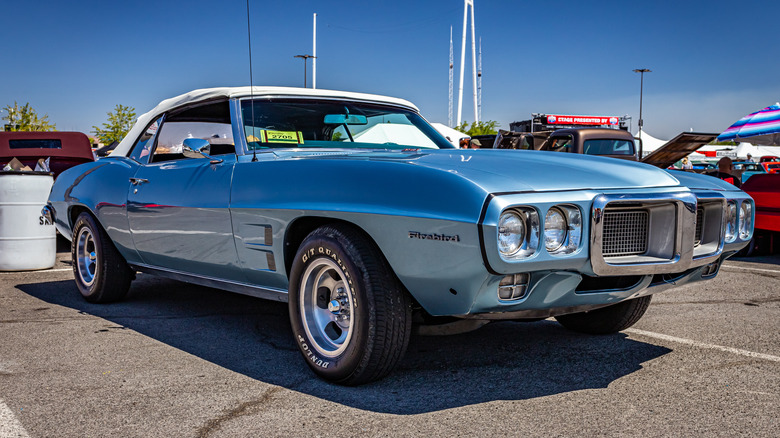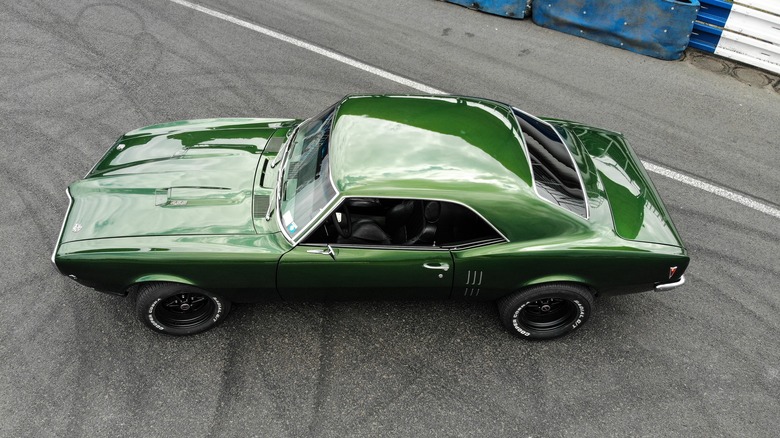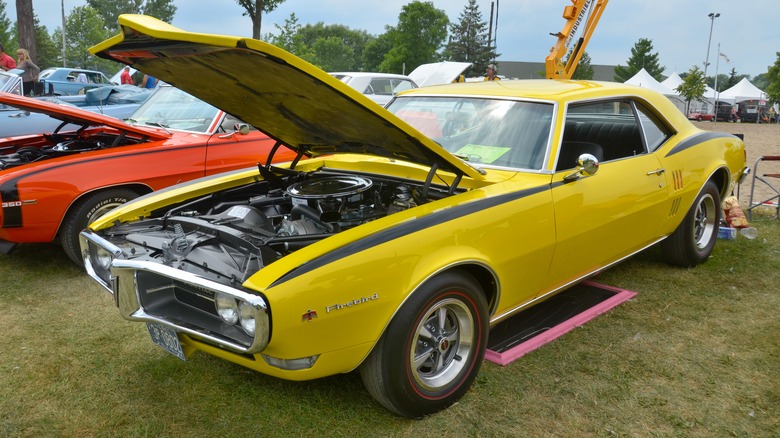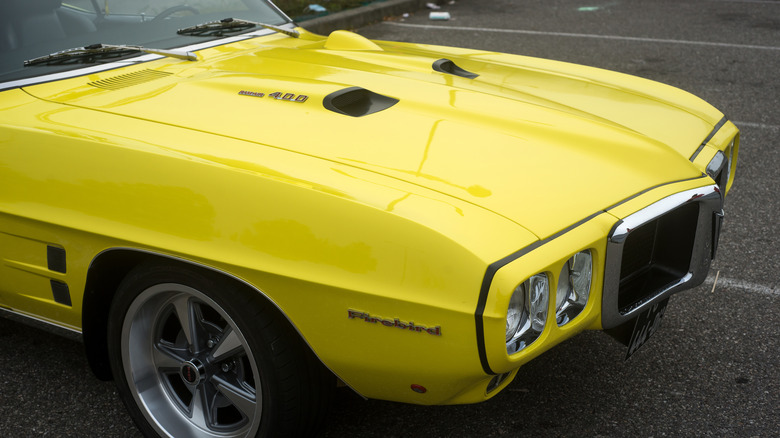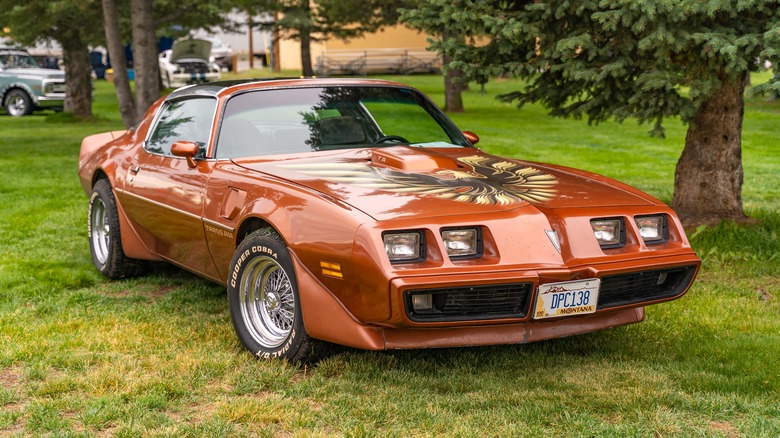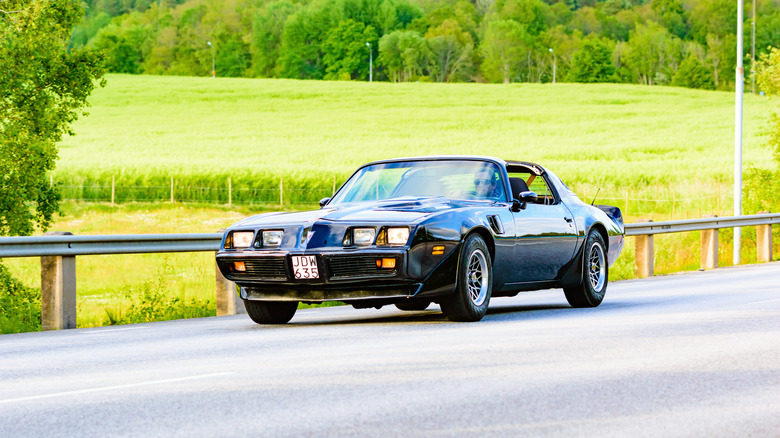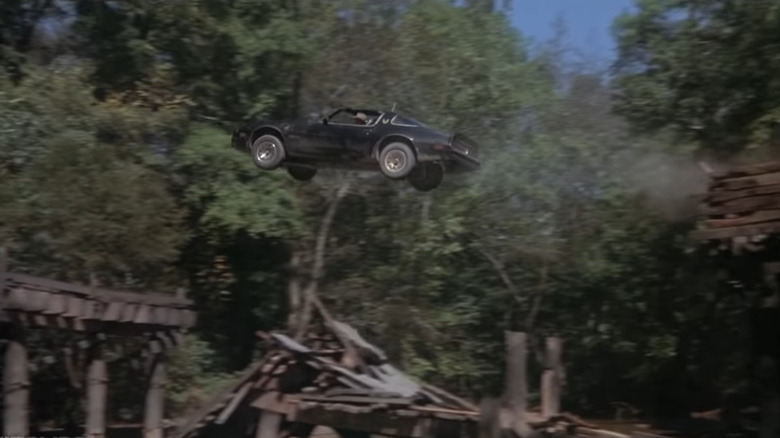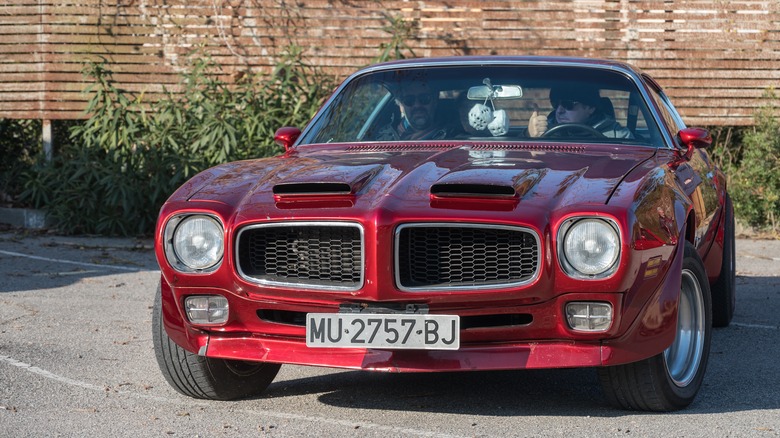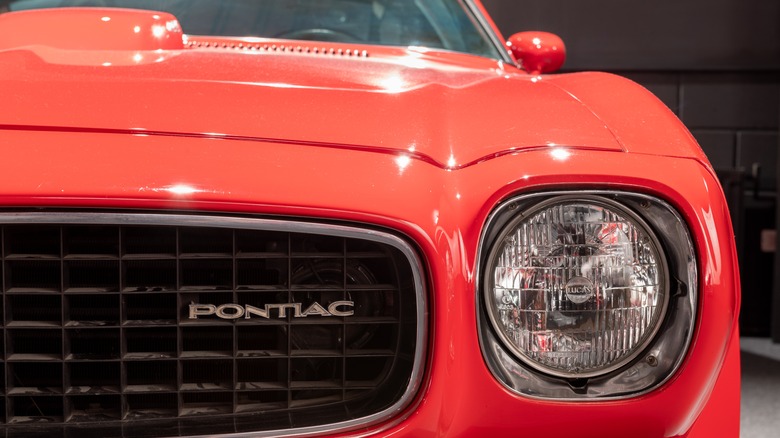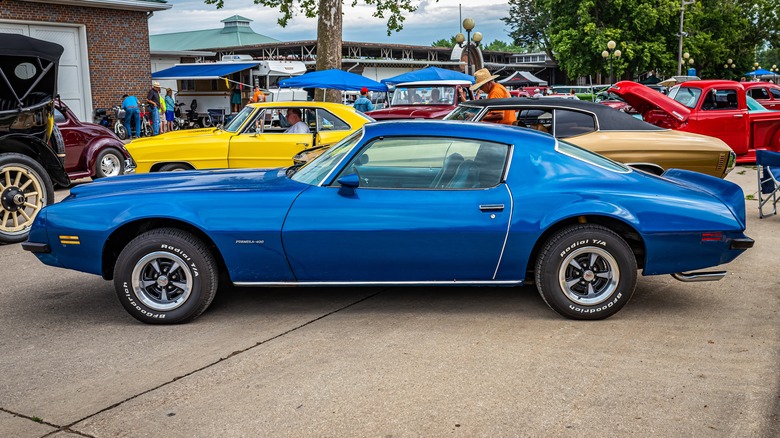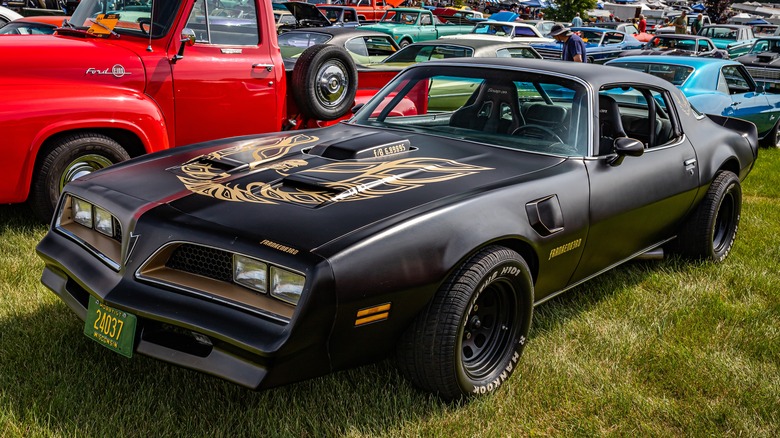10 Reasons A Classic Pontiac Firebird Is Still Worth Buying Today
A car can do so much more than get you from point A to point B. It can be an extension of your personality and make people whip their heads to look any time you drive down the highway. Of course, there's nothing wrong with modern sedans and minivans, but you may just find yourself with an itch to ride around in something that harkens back to the days when muscle cars ruled supreme. People these days may be concerned about things like fuel economy, but in your head, it's all about style, and few vehicles are as stylish as a classic Pontiac Firebird.
While Firebirds were produced into the 2000s, a "classic" iteration would likely be from the first or second generation — think 1960s up until about 1981. These are generally seen as the best generations of the Pontiac Firebird, and it's easy to see why. They packed a punch, with some models even being adorned with the iconic "Screaming Chicken" decal on the hood. The Firebird came to exemplify everything great about American car culture in that era.
There are numerous reasons why you may want to consider buying a classic Pontiac Firebird in this day and age. Let's walk through some of the advantages these cars still hold, just in case you need to convince a partner that it is, in fact, a good idea.
Timeless design
Let's get this out of the way up top: The Pontiac Firebird simply looks awesome. It's probably the first image that comes to mind when people think of "muscle cars," and it truly makes a statement. Even without any extra add-ons, the 1967 Pontiac Firebird 400 remains one of the coolest-looking Pontiac models ever made, and the folks behind it put everything they had into capturing a one-of-a-kind aesthetic.
In an interview with Dean's Garage, former Pontiac chief designer Bill Porter spoke about everyone's attitude at getting to work on a particular model: "That '70-1/2 second generation Firebird was another story altogether. I was absolutely crazy about that car from day one and really threw myself into it. I put the best designers I had on it and we were on consciously trying to create an important American sports car."
That's not even getting into the design from the late 1970s that had four rectangular headlights and a hood with a lower profile. The fact the Firebird has so many different stand-out designs really speaks to how much care and attention went into maintaining its reputation as a classic muscle car. And since they definitely aren't as common on the road these days, they make an impression wherever they go.
Powerful engine
Looking good is one thing, but any driver worth their salt will want to make sure they can back it up with a powerful engine under the hood. The first couple of generations of the Pontiac Firebird had precisely that. The 1967 line-up of Firebirds had engines that could produce between 165 and 285 horsepower. These big block V8s were commonplace in muscle cars, responsible for adding the aforementioned "muscle." Sadly, not all good things can last.
The auto industry was hit hard by the 1973 oil crisis, which saw the Organization of Petroleum Exporting Countries (OPEC) impose an embargo on the United States, which led to fuel shortages in the country. As such, a greater emphasis was placed on tighter emissions and greater fuel economy, with people needing to be wiser about how they spent their gas. Engines across the board had to be refined, and as such, the Firebird engine had to be caged.
Pontiac still managed to put some decent engines in later models, like the 1978 model's spark-ignition four-stroke engine, which was capable of hitting 220 horsepower. However, these days a Firebird with an original engine is quite a find, especially among collectors.
Excellent handling
Throughout the 1960s and '70s, muscle cars weren't particularly known for their handling. With big-block engines, cars were built for acceleration, so someone could drive it down the street fast, but they might run into issues when trying to take corners. However, certain models of the Pontiac Firebird offered much smoother rides, providing a good amount of sheer force while also not instilling dread in drivers when they have to turn suddenly.
In a 1979 issue of Car and Driver, the outlet declared the 1979 Pontiac Firebird Trans Am had the best handling, even up against something like a Chevy Camaro. When bestowing the honor, Car and Driver wrote, "The Trans Am wins because it predictably delivers nearly anything you ask of it and it coolly reports on the delivery every foot of the way."
Drivers also have the option of getting the 1979 Pontiac Firebird Trans Am WS6, which came with an additional package that provided a compressed steering ratio. In the modern day, this particular model is a good option for owners who plan on taking their car out for spins regularly and don't want to worry about unexpected surprises when taking corners.
Robust community
When you buy a classic Pontiac Firebird, you naturally want to show it off for the world to see. And the type of people who are probably going to appreciate your vehicle the most are other Firebird owners. It's a surprisingly large community, both online and in the real-world, and you may just make some new friends in the process.
There's a host of online forums where you can talk shop and learn all kinds of things about this particular ride. There's a dedicated Pontiac Firebird subreddit as well as the Firebird Nation Forum where there are numerous threads for pretty much anything you can imagine for your car. You can simply post pictures of your Firebird or ask for help if you need to do a little maintenance and want to see if anyone else has some tips.
You also don't want to overlook FirebirdFest, where Firebird owners travel from all over to show off their pride and joy, and participate in all sorts of events. Firebirds are among the most collectible Pontiac cars, and FirebirdFest is your chance to see all of them in one place. And those friends you made online may just become your pals IRL.
Potential return on investment
While owning a classic Pontiac Firebird and keeping it in your collection will undoubtedly bring you a lot of joy, the day may come when it's time to sell it. Maybe you need to make room for another car that's caught your eye, or someone's just offered the right price. Anyone needing to have reasoning to purchase a Firebird in the first place can rest easy knowing these vehicles are highly collectible and may sell for a pretty penny if you know what you're doing.
Naturally, resale value is dependent on a litany of factors, such as the specific model and year. The condition in which it's kept in also plays a big role because a Firebird that's street-ready right off the bat will sell for more than one that needs some maintenance. Some Firebird models sell for $50,000 or even higher. The classic models, which are those first and second generations, naturally sell for more than the ones that came out in the '90s.
A classic Firebird should be seen as an investment. You may need to put some money into it to get it driving smoothly once again, but you could recoup it and then some down the line.
A Hollywood legend
Car collectors with a soft spot for the silver screen will want to consider a Pontiac Firebird if for no other reason than it's a genuine Hollywood icon. Arguably, the Firebird's biggest claim to fame is that it's the car Bo "Bandit" Darville (Burt Reynolds) drove in 1977's "Smokey and the Bandit." It's even part of one of the most iconic car chases in movie history when Bandit sends it flying over the Mulberry Bridge with the authorities in pursuit.
Firebirds have been found in an array of other movies and TV shows, from "Cannonball!" to 2008's "Death Race." But the Pontiac Firebird Trans Am will forever be affiliated with "Smokey and the Bandit" above all others, which makes it a shame the ones used during production were all pretty much totaled by the end of filming and aren't around anymore. One promo car from the film was sold at auction in 2016, but it's safe to say that's going to be far more expensive than what a general Firebird will run you.
Easy customization
Anyone with plans to resell their Pontiac Firebird may want to make it as easily marketable as possible. However, if you want your Firebird to reflect your personality, or you feel like doing an engine swap to give it that classic muscle car feel, these cars are relatively easy to customize.
Firebirds have a great deal of aftermarket support, especially for older models where parts aren't always easy to come by. There are naturally different types of customization to pursue, such as new aesthetics — maybe your specific Firebird doesn't have that Screaming Chicken decal on the hood and you want to add one.
And you know that large Firebird community we were talking about earlier? It's a safe bet if you have any questions about tracking down a specific part or recommendations on how to make your car stand out, someone out there would be willing to offer advice. Firebirds already make a statement on their own, and with a little love and care, you can make yours even more pronounced.
Smooth manual transmission
For some, driving just isn't driving unless it's with a manual transmission. Driving stick shift is an art form in itself, but fortunately there are some beginner tips to learn manual transmission shifting relatively painlessly. Manual transmission gives the driver a greater array of options for engaging in the experience of driving, taking into account things like road conditions and inclines so that the car operates smoothly. Automatic transmissions are far easier to come by because they take away a lot of the guesswork, but for those who love the feel of a stick shift, a classic Pontiac Firebird has you covered.
Older models of the Firebird came with that classic stick shift, which was gradually faded out over the years. That's the case in the auto industry as a whole, as car manufacturers opt for focusing more on electric vehicles, which come with single-speed transmissions. It's another reason why getting a Pontiac Firebird may be an enticing proposition. By keeping these cars in rotation, you're keeping a legacy alive, and you can impress all your friends that you know how to drive manual next time you give them a ride. If that's not enough, manual transmission tend to be easier and more affordable to repair.
Relatively affordable
As stated previously, Pontiac Firebirds can be highly collectible and worth a lot of money for the right model. But how much is a Pontiac Firebird worth today if you're just looking to get one to begin with? More modern Firebird models from the 1990s usually don't sell for as much as the classics, but obviously, that vintage design is what a lot of people want. Fortunately, it's still possible to get those first and second generation models without breaking the bank.
Some cursory research shows there are Firebirds from 1967 to 1981 that you can get ranging from $10,000 to roughly $30,000. As is the case with buying any used car, you want to do your research and give the vehicle a thorough inspection before believing in something that's too good to be true. Then again, a lot of people buy Firebirds as projects, so if you plan on putting some work and money into the vehicle anyway, a couple dings may not be the worst thing.
Again, this comes down to models and years. The 1977 Pontiac Firebird Trans Am tends to be more costly since that's the one from "Smokey and the Bandit." But if you're looking to simply get started with a classic car collection, a Firebird from another year may be a more manageable way to go about that.
A piece of car history
Pontiac Firebirds were officially discontinued in 2002, and the brand itself wasn't much longer for this world. General Motors got rid of Pontiac as a whole in 2009 after its cars hadn't been profitable for quite some time. Unless the brand gets revived in some way in the future, there aren't any new Pontiacs getting made. That means for anyone who wants a piece of automotive history, in addition to a cool piece of engineering to show off, a classic Pontiac Firebird is the way to go.
Pontiac produced numerous makes and models over the years, many stylish or well-running in their own right. But the Firebird was the pride and joy of the company for decades, and a pop culture staple. And it may be cliche to say, but they just don't make cars like this anymore. There was so much personality in the design, with a high-powered engine to boot.
Pontiac Firebirds are still worth buying today because they can still run with the best of them. But whether you just want to look at yours or take it out on the road for all to see, there's no wrong way to enjoy a Firebird.
